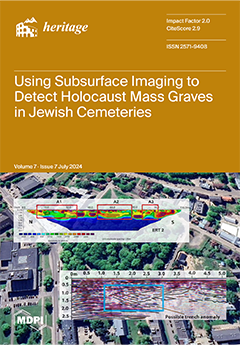The Japanese textile tradition is renowned for its intricate designs achieved through a variety of dyeing techniques, including
kasuri,
shibori, and paste-resist dyeing. These techniques are often combined within a single textile, resulting in exceptionally elaborate creations. Our paper delves into
[...] Read more.
The Japanese textile tradition is renowned for its intricate designs achieved through a variety of dyeing techniques, including
kasuri,
shibori, and paste-resist dyeing. These techniques are often combined within a single textile, resulting in exceptionally elaborate creations. Our paper delves into the technical aspects and complexities of these methods, highlighting the dynamic interplay between tradition and innovation in Japanese textile production. Our scientific endeavour focused on some textiles dating between the 19th and 20th centuries and belonging to the Montgomery Collection of Japanese folk art. Employing non-invasive techniques such as visible reflectance spectroscopy and ER-FTIR spectroscopy, we uncovered key insights into the materials and methods utilized in the creation of these textiles. Our analysis revealed a diverse array of pigments and dyes, including plant-derived, inorganic, and synthetic variants. These findings illuminate the cultural syncretism between traditional Japanese practices and the adoption of new materials from the West, underscoring the dynamic nature of textile production in Japan. Furthermore, ER-FTIR spectroscopy elucidated the predominant use of cotton as the primary fibre in the textiles, aligning with historical records of Japan’s role as a major producer of cotton yarn. Analysis of white areas within the textiles revealed evidence of resist-paste dyeing techniques, particularly
tsutsugaki and
katazome, through the absence of dye penetration and the characteristic appearance of white lines. Confirmation of indigo dyeing techniques (
aizome) was achieved through ER-FTIR spectroscopy, providing reliable identification of indigo and Prussian blue in various shades of blue present in the textiles. Additionally, the detection of Western-derived dyeing method (
utsushi-yūzen) and free-hand painting (
kaki-e), offers insights into the diversity of dyeing practices employed by Japanese artisans. The presence of proteinaceous materials and synthetic dyes observed in some textiles has implications for conservation practices, suggesting the need for tailored approaches to ensure the preservation of these culturally significant artifacts. Overall, these scientific results shed new light on the materials, techniques, and cultural contexts underlying Japanese textile production, advancing our understanding of this rich artistic heritage and informing future research endeavours in textile science and conservation.
Full article





